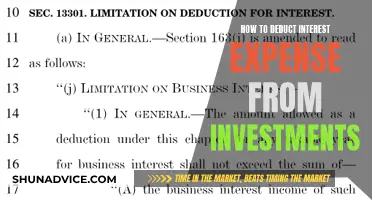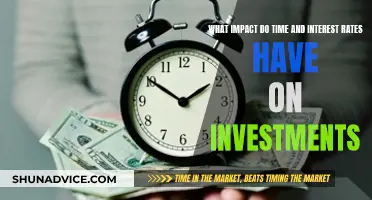
The Federal Reserve System (also known as the Fed) is the central banking system of the United States. It is designed to help the economy stay healthy, which means maximising employment and promoting economic growth while maintaining prices. The Fed has a significant impact on the stock and bond markets, and investors need to be aware of how to invest their money when interest rates are rising or falling. For example, when the Fed cuts interest rates, it reduces the rate that banks charge one another when lending money, which can lower borrowing costs for consumers and businesses. On the other hand, when the Fed raises interest rates, it can slow down economic performance and ease inflation.
| Characteristics | Values |
|---|---|
| Interest rates | 3-3.25% |
| Economic growth | 0.2% for 2022, 1.2% for 2023 |
| Unemployment | 3.7% (2022), 3.8% (end of 2022), 4.4% (2023) |
| Inflation | Expected to drop over the next 12 months |
| Investor options | Pair trades |
| Federal Open Market Committee (FOMC) meetings | Two more before the end of the year |
What You'll Learn

How to invest if the Fed keeps raising interest rates
The Fed is expected to keep raising interest rates into next year, even at the cost of slowing down the economy. This is likely to have an impact on the stock and bond markets, so investors may be wondering how they should be investing their money today and if they should be making changes to their portfolios.
One option is to move some funds out of the markets and into cash accounts, as interest rates on these accounts are increasing. However, there are a couple of issues with this strategy. Firstly, most investors are likely to be sitting on some hefty losses, and selling and moving to cash will lock these in. Secondly, the best CD rates on the market are still only just over 3%, and these come with serious lock-in periods of up to five years.
Another option is to think outside the box and consider pair trades. This involves taking a long position in one stock and a short position in another stock in the same sector. This can help to hedge against market risk and provide a profit even if the sector as a whole is declining.
It's also important to keep an eye on economic projections and adjust your investment strategy accordingly. For example, the Fed is projecting inflation to drop significantly over the coming 12 months, which could impact the performance of certain sectors.
Investing for Compound Interest: Does it Work?
You may want to see also

How the Fed raising interest rates can affect the stock and bond markets
When the Fed raises interest rates, it can have a significant impact on the stock and bond markets. The Federal Reserve is designed to help the economy stay healthy, maximising employment and promoting economic growth while maintaining prices.
Raising interest rates can slow down the economy, which can affect stock and bond markets. Investors may wonder how they should be investing their money and if they should be making changes to their portfolios.
One option for investors is to consider pair trades, which can help generate profits in a challenging environment. It's important to note that most investors are likely to be sitting on losses, and selling and moving to cash accounts with higher interest rates can lock in these losses.
Additionally, the Fed's decision to raise interest rates can impact borrowing costs for consumers and businesses. Higher interest rates may slow down economic performance, but they can also help ease inflation.
Negative Interest Rates: Strategies for Smart Investing
You may want to see also

How to invest your money when interest rates are rising
When interest rates are rising, investors may wonder how they should be investing their money and if they should be making changes to their portfolios.
The U.S. Federal Reserve is designed to help the economy stay healthy, which means maximising employment and promoting economic growth while maintaining prices. When the Fed cuts interest rates, it is reducing the rate that banks charge one another when lending money to satisfy the federal reserve requirements. The Fed decides to cut rates, which can lower borrowing costs for consumers and businesses, with the idea that the reduced cost of capital may give both more confidence to spend and invest. Low interest rates help stimulate economic activity and boost employment; high interest rates slow economic performance and ease inflation.
With interest rates increasing on cash accounts, it might be tempting to move some funds out of the markets and into this safe haven. However, most investors are likely to be sitting on some pretty hefty losses right now, and selling and moving to cash is going to lock these in. The best CD rates on the market are still only just over 3%, and these come with serious lock-in periods of up to five years.
Investors need to think outside the box to generate profits in this type of environment, and pair trades are one option to consider.
Understanding Long-Term Investment Interest Rates
You may want to see also

How to invest during rate cuts
When the Fed cuts interest rates, it reduces the rate that banks charge each other when lending money to satisfy federal reserve requirements. This can lower borrowing costs for consumers and businesses, with the idea that the reduced cost of capital may give both more confidence to spend and invest. Low interest rates help stimulate economic activity and boost employment, while high interest rates slow economic performance and ease inflation.
When the Fed cuts interest rates, investors may wonder how they should be investing their money and if they should be making changes to their portfolios. It's important to remember that most investors are likely to be sitting on some pretty hefty losses, and selling and moving to cash is going to lock these in. The best CD rates on the market are still only just over 3%, and these come with serious lock-in periods of up to five years.
Instead, investors need to think outside the box to generate profits in this type of environment, and pair trades are one option to consider. It's also worth noting that the Fed raising interest rates can affect the stock and bond markets.
How to Spark Interest in Investing
You may want to see also

How to invest if the Fed keeps raising interest rates
With the Fed raising interest rates, investors may wonder how they should be investing their money and if they should be making changes to their portfolios.
It is important to remember that the U.S. Federal Reserve is designed to help the economy stay healthy, which means maximising employment and promoting economic growth while maintaining prices.
The Fed's decision to raise interest rates can have an impact on the stock and bond markets. With interest rates increasing on cash accounts, it might be tempting to move some funds out of the markets and into this safe haven. However, there are a couple of major issues with that. Firstly, most investors are likely to be sitting on some pretty hefty losses right now, and selling and moving to cash is going to lock these in. Secondly, the best CD rates on the market are still only just over 3%, and these come with serious lock-in periods of up to five years.
Instead, investors need to think outside the box to generate profits in this type of environment, and pair trades are one option to consider. It is always possible to explore unique angles to seek profits.
Why Investment Homes Have Higher Interest Rates Than Second Homes
You may want to see also
Frequently asked questions
Rising interest rates can slow down the economy and reduce economic growth. This can cause investors to lose confidence and move their funds out of the markets and into cash accounts.
Investors need to think outside the box to generate profits in this type of environment. Pair trades are one option to consider.
The U.S. Federal Reserve is designed to help the economy stay healthy, which means maximising employment and promoting economic growth while maintaining prices.







